Palsang-do – The Eight Scenes from the Life of the Buddha Murals: 팔상도
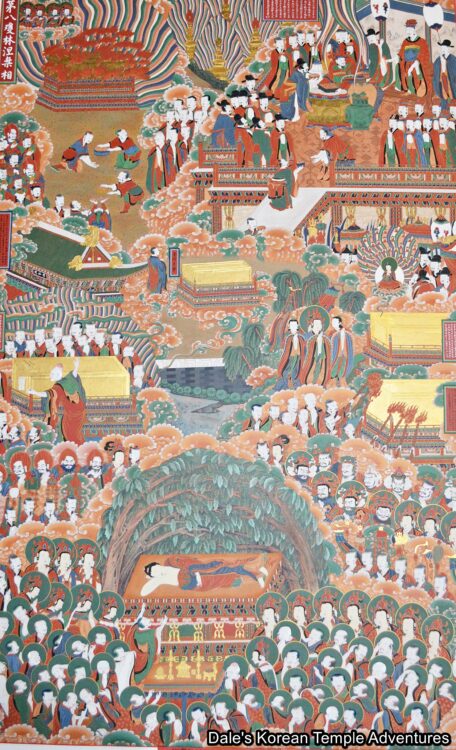
Introduction
There’s various artwork that typically adorns a Korean Buddhist temple both in and around temple shrine halls. And one of the most popular pieces of artwork is the Palsang-do (The Eight Scenes from the Life of the Buddha Murals) set. This set is a collection of eight murals that depicts the Buddha’s life from birth to death. Typically, they can be found around the exterior walls of a Daeung-jeon Hall, or they can appear inside a Palsang-jeon Hall like at Beopjusa Temple or Beomeosa Temple.
These paintings can range in complexity and overall sophistication. And while they do vary in composition, they all depict the same eight scenes, and they all have Seokgamoni-bul (The Historical Buddha) as the central figure in these paintings. The Palsang-do murals first appeared two thousand years ago, and they were first created to satisfy people’s interest in the Buddha.
The eight paintings in the Palsang-do set are:
1. The Announcement of the Imminent Birth
2. Birth
3. The World Outside the Palace
4. Renunciation
5. Asceticism
6. Temptations
7. Enlightenment
8. Death
Palsang-do Design
Here’s a bit more information about each of the individual paintings. What they look like, and what they’re meant to symbolize.
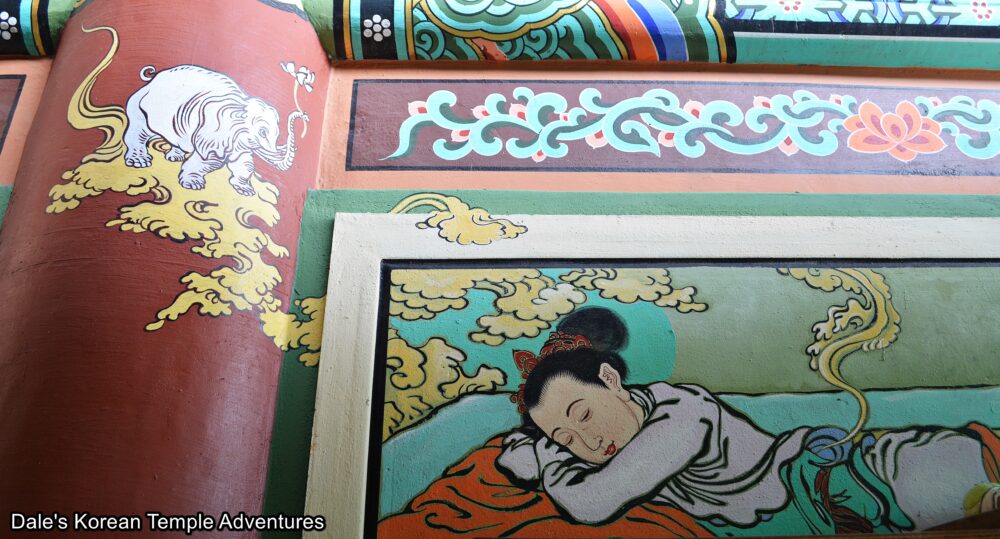
1. The Announcement of the Imminent Birth:
In this painting, you’ll find Queen Māyā of Sakya, the Buddha’s mother, sleeping. Joining Queen Maya in this painting is a white elephant.
The white elephant in this painting is a symbol of strength, patience, loyalty, and wisdom. When Queen Maya became pregnant, she had a dream of a white elephant. The white elephant was offering her a white lotus from its trunk. After this, the white elephant then circled Queen Maya three times and then entered her womb with its tusk. Upon waking, Queen Maya knew that she had experienced something spiritual. A Brahmin was consulted to interpret the significance of this white elephant dream. The Brahmin said, “A great son will be born. If he renounces the world and embraces a religious life, he will attain perfect enlightenment and become the saviour of this world.”
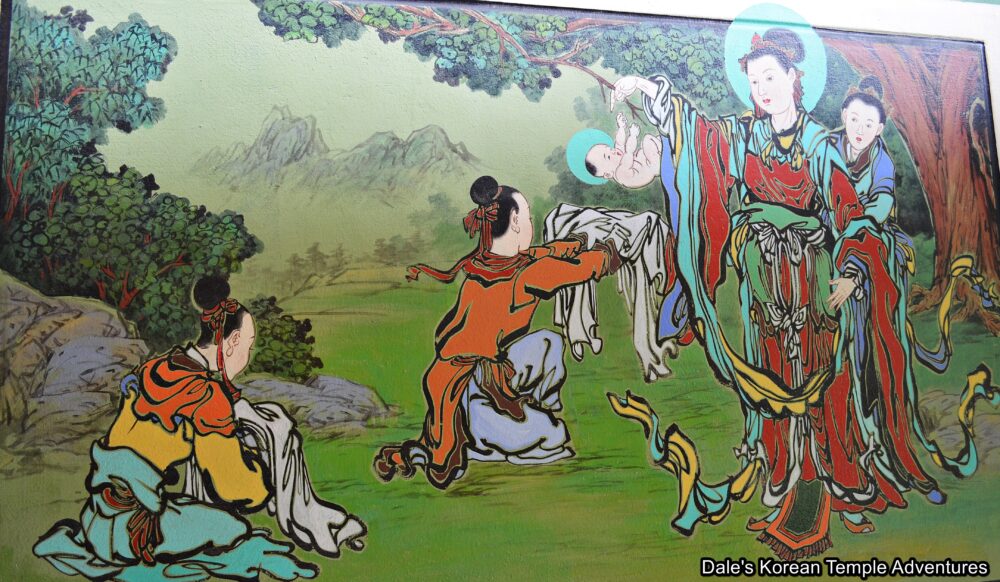
2. Birth:
In this second mural of the set, you’ll see Queen Maya typically holding a fig branch in her hand. Queen Maya appears in a royal palace setting with nine dragons washing the baby Siddhārtha Gautama. The standing image of Siddhārtha Gautama is joined by earthly attendants.
In this painting you’ll see the Buddha, Seokgamoni-bul, being born. Seokgamoni-bul (The Historical Buddha) was born a prince in 624 B.C. in Lumbini, Shakya Republic, which was apart, at that time, of northern India. Presently, it’s situated in southern Nepal and northern India near the Himalayas. The baby Siddhārtha Gautama, the Buddha before he was famously known as the Buddha, emerged from the right side of his mother both well developed and fully clothed. Immediately, he began to walk after his birth. Tragically, and only seven days after his birth, his mother, Queen Maya, died. Despite this early loss, Siddhārtha Gautama would live a happy and comfortable childhood.
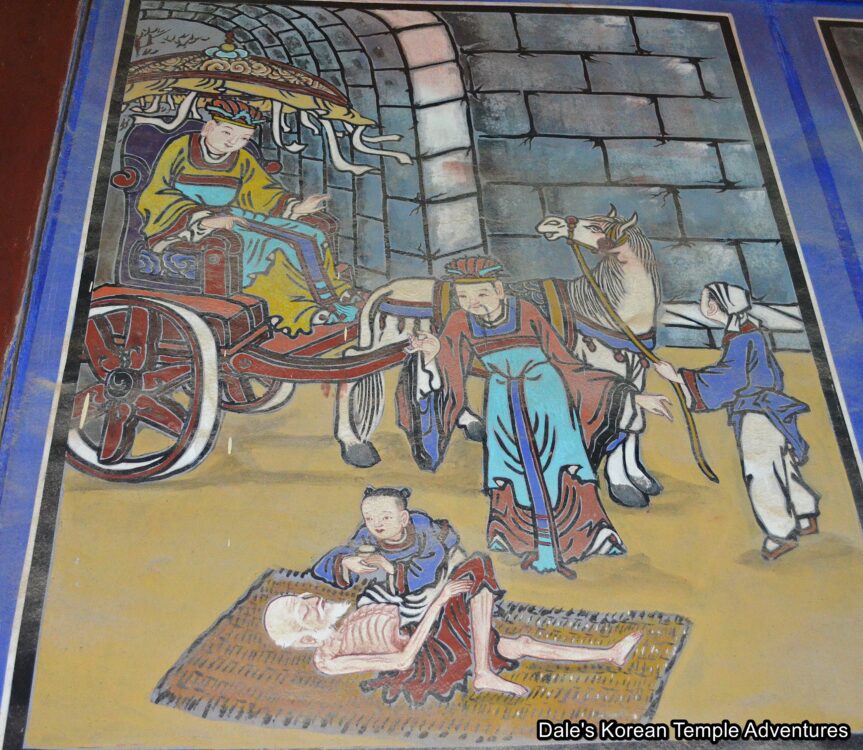
3. The World Outside the Palace:
In simpler renditions of this painting, you’ll find a single emaciated individual being observed by Siddhārtha Gautama. And in more complex paintings, you’ll see a palace complex to the left and the suffering of everyday people to the right.
As Siddhārtha Gautama grew older, he started to go outside the protection of the palace walls. He ventured out into the capital to see his father’s kingdom. Before this, Siddhārtha Gautama knew nothing about suffering, sickness, and death. He had lived a sheltered life. It was during these travels that he first encountered sickness, old age, and death. As a result of seeing this suffering, which was a completely new side to life, a side that was virtually unknown to him at this point in his life, it left a deep impression on Siddhārtha Gautama. He felt compassion for other people, and he wanted to find a way to free people from their suffering. It was a little later that Siddhārtha Gautama decided to leave his former life behind. Leaving his wife, child, and royal upbringing behind, Siddhārtha Gautama left the security of the palace walls behind for solitude and meditative insights, which he hoped would help him gain a greater insight into the human condition.
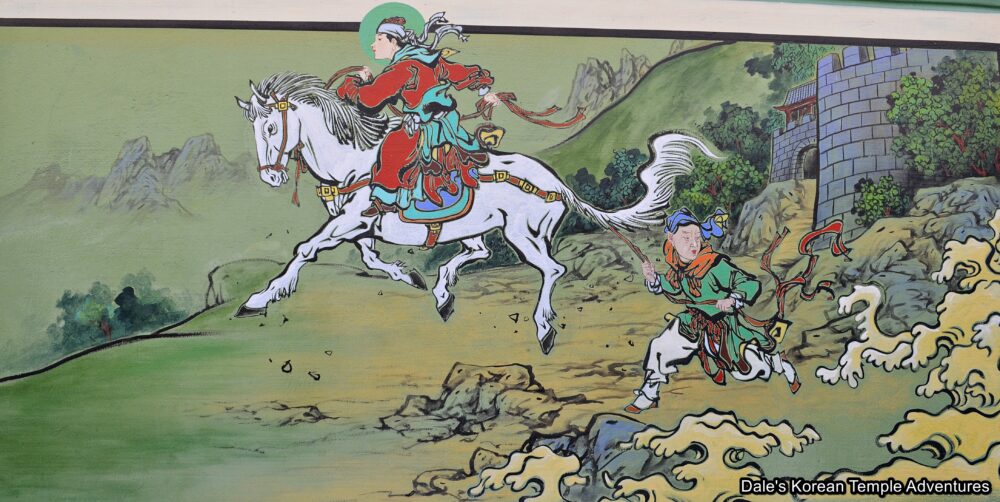
4. Renunciation:
In this fourth painting of the set, you’ll see a white horse with Siddhārtha Gautama on top of it. Together, they are in flight over the palace walls. Sometimes, you’ll find guardians like the Sacheonwang (The Four Heavenly Kings) assisting Siddhārtha Gautama over the palace walls. Siddhārtha Gautama is joined by his faithful servant, Channa, who is hanging onto the tail of his master’s white horse, Kanthaka.
In this painting, Siddhārtha Gautama’s father learned about his son’s intention of leaving the royal palace. So the king placed extra guards around the palace. However, with the help of the Four Heavenly Kings (yes, those very same guardians found inside a Korean Buddhist Cheonwangmun Gate), Siddhārtha Gautama was lifted over the palace walls.
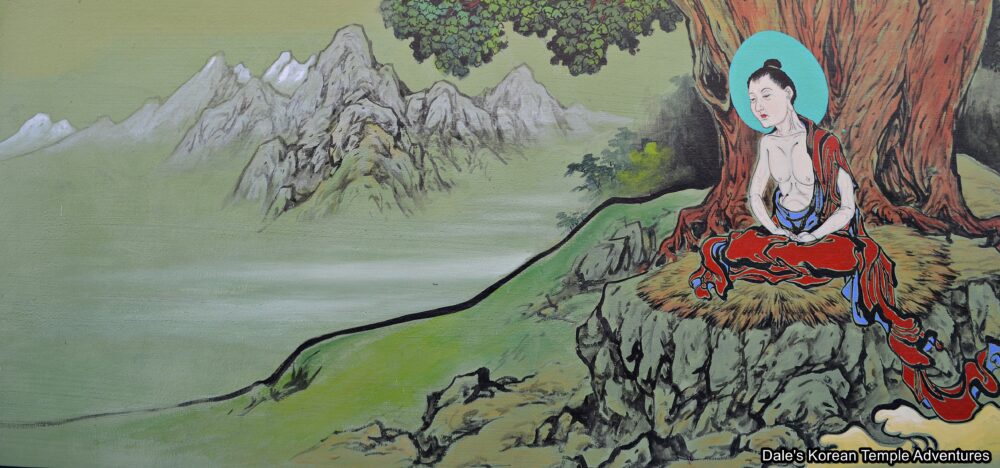
5. Asceticism:
In this fifth mural in the Palsang-do set, you’ll find a suffering and starving Siddhārtha Gautama. In this painting, Siddhārtha Gautama is depicted as being bone thin. He’s also meditating under the shade of a tree.
For six years Siddhārtha Gautama had studied and meditated to find truth. As was customary for ascetics of this time, Siddhārtha also physically punished his body in his search for truth. So the ravages of not eating enough food are made plain in this painting. In fact, Siddhārtha Gautama was close to death. Finally realizing that this type of lifestyle wasn’t leading him towards enlightenment, Siddhārtha Gautama started to live a life of moderation. In doing this, he hoped that by taking better care of his body that it would lead to a more successful pursuit of ultimate enlightenment.
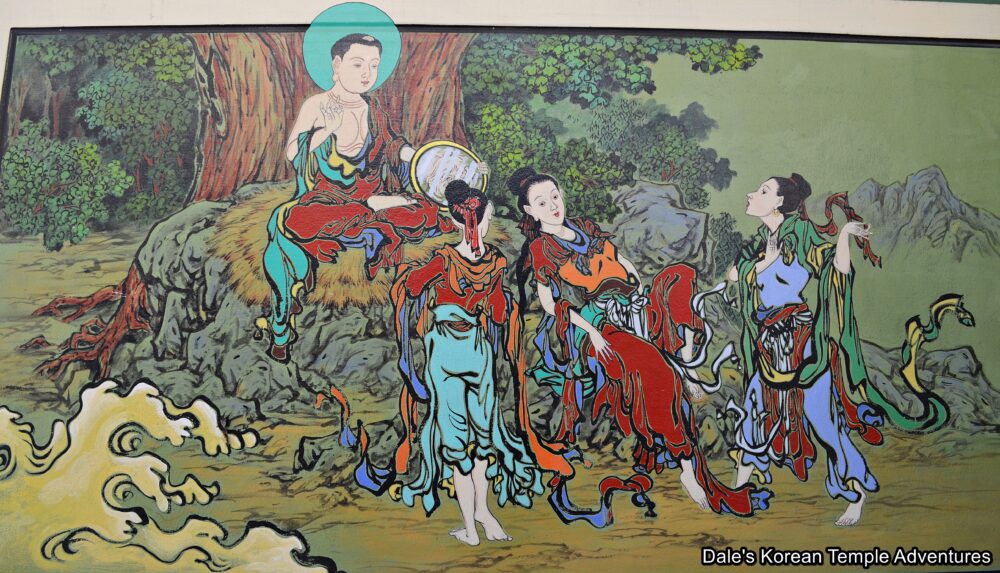
6. Temptations:
In this sixth painting, there are three voluptuous women that dance around Siddhārtha Gautama, as he’s attempting to attain enlightenment. In their hands, they hold mirrors. If you look closely at the mirrors, you’ll see that the beautiful women actually have demonic faces.
What this all symbolizes is the demon Mara’s attempt to thwart Siddhārtha Gautama from attaining enlightenment. If Siddhārtha Gautama did in fact attain enlightenment, it would free people from their suffering. So attempting to disrupt Siddhārtha’s meditation, Mara sent his three daughters Taṇhā (thirst, craving, desire), Raga (attachment, greed, passion), and Arati (aversion, discontent) to tempt Siddhārtha Gautama. When this didn’t work, Mara threatened Siddhārtha Gautama with a sword and screamed, “Monk, what are you seeking while seated so low? Come out quickly! You are useless while sitting in that holy posture!” Siddhārtha answered, “I alone, below the heavens, can sit in this posture. Earth Spirit, you are my witness.” And with this, Siddhārtha changed his pose to the mudra (ritualized hand gesture) of opening his right hand and pointing his right index finger to the earth, while his left hand remained on his lap. This mudra is known as the “Touching the Earth Mudra.” Having defeated temptation, Siddhārtha Gautama attained enlightenment and became the Buddha.
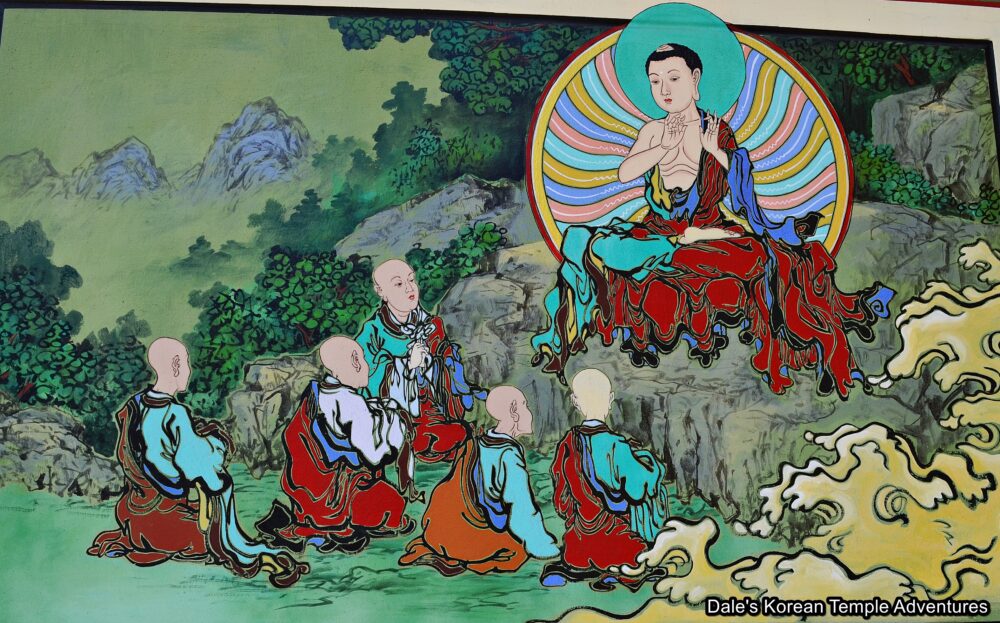
7. Enlightenment:
In the seventh mural in the Palsang-do set, you’ll see the Buddha (Seokgamoni-bul) have a halo around his head. He is surrounded by his disciples. He is teaching in The Deer Park in Sarnath, where he first taught the Dharma. Among his disciples, you’ll typically see an assortment of wandering deer. And in more complex paintings, you’ll see celestial and worldly creatures and figures alongside the deer, as well as the Buddha’s disciples, the Nahan.
After attaining enlightenment at the age of thirty-five, Siddhārtha Gautama became the Buddha (Seokgamoni-bul). And for the next forty-five years, the Buddha would teach anyone that would listen how to achieve enlightenment.
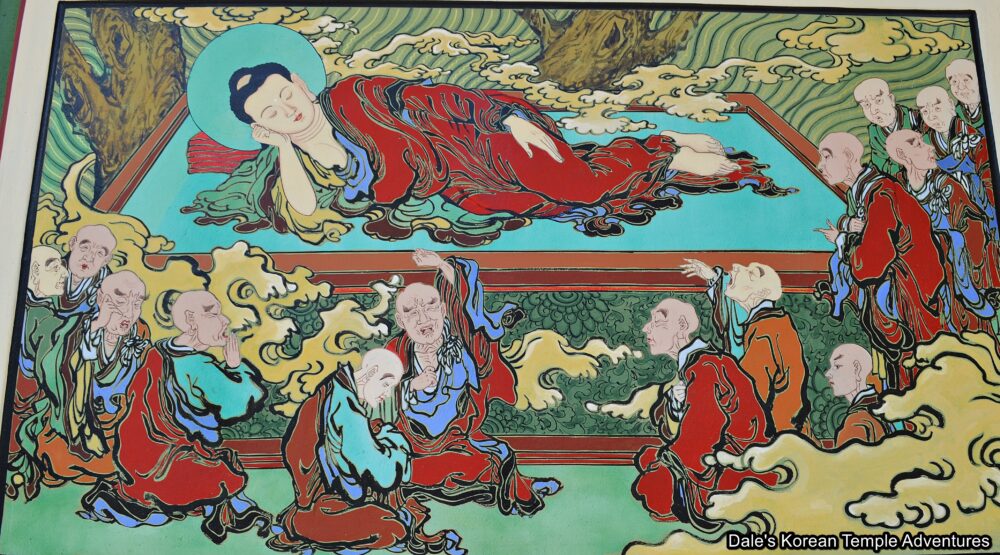
8. Death:
In this eighth, and final, mural in the Palsang-do set, you see the life of the great teacher coming to an end. The Buddha is on his right side, and a collection of earthly and celestial creatures have gathered around the Buddha like dragons, tigers, turtles, and the Nahan (The Historical Disciples of the Buddha).
Conclusion
Whether the Palsang-do, or “The Eight Scenes from the Life of the Buddha Murals,” in English, are masterful or simple in composition, they tell the amazing life story about a man who inspired, and continues to inspire, a countless amount of people for two and half millenniums: the Buddha, Seokgamoni-bul. And whether you believe in Buddhism or not, these wonderful murals at Korean Buddhist temples are worth a second, and even a third, glance while exploring a temple’s grounds.